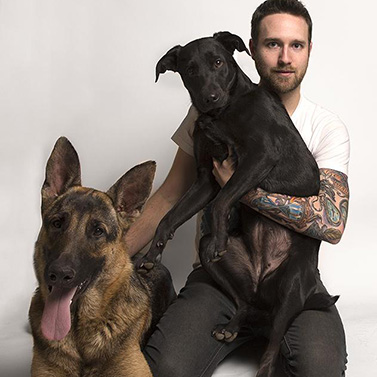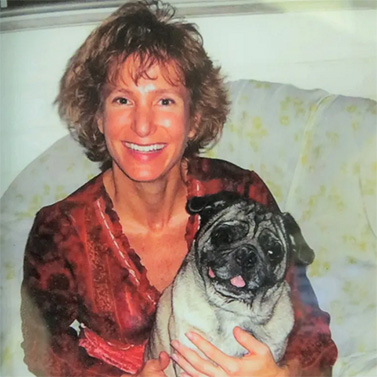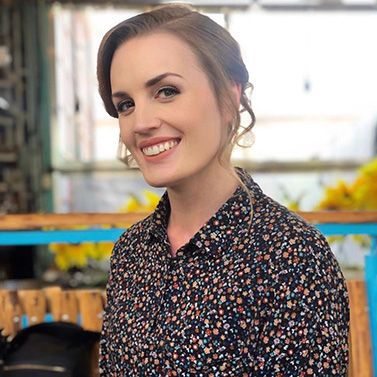Feb 16, 2021
It is hard to resist a pug with big, bulging eyes and wrinkled skin. Unfortunately, the very same attributes that make them so cute leave them vulnerable to infection, low stamina, and other health conditions. Taking care of a pug requires special attention to possible symptoms and extra care. See what our panel of pug lovers recommends for keeping your pug healthy and strong.

Aaron Seminoff is a dog trainer and long-time pug dad from California. He spends most of his free time with his two rescue dogs Link & Zelda and volunteering with animal rescues. Aaron has fostered over 50 rescue dogs – helping to find them the perfect forever homes. Find him at Animalhearted.com
- Pug breathing problems
- Pug skin problems
- Just need some special care
- Health practices
- Look after your boy
- Kept at a healthy weight
- Get a regular health checkups
Pug breathing problems
Pugs are bred to have short, flat noses. Unfortunately, this practice makes them susceptible to Brachycephalic Obstructive Airway Syndrome or BOAS. This [condition] is caused by their nostrils being too small, which obstructs airflow making them short of breath. I remember the first time my pug started wheezing and panting on a hot summer day, and it scared me half to death. This is a common occurrence when pugs are physically active or exposed to heat. [It] can be very loud and disconcerting if you aren’t expecting it.
Solution: Listen to your pug. The sooner you are able to catch them starting to breathe heavily, the sooner you can bring them inside or get them water if they are overheating. Do not run with your pug. While brisk walks are fine and healthy for your pug, taking them on runs can be incredibly harmful to them. Be aware of how hot it is and know when you need to cool off your pug by either bringing them inside a temperature-controlled room or giving them water to cool them off. If you know the warning signs for your pug’s shortness of breath, you will be able to alleviate their breathing [issues] faster.
Pug skin problems
Pugs are extremely prone to skin conditions. This is largely due to all of the wrinkles in their skin, which make an ideal breeding ground for bacteria and fungus to grow. The two most common skin conditions in pugs are ringworm and allergies.
Ringworm is an infection caused by a fungus that is contagious and can be picked up from numerous places. You can usually spot ringworm from its signature ring-shaped wound and hairless spot on your dog’s skin. It’s a good idea to get in the habit of checking your pug every night to catch ringworm early on. Try making it a nightly routine so you don’t forget. It’s also important to wash your dog’s toys, bedding, and your hands to prevent the ringworm from spreading.
Allergies in pugs generally show up as incessant scratching and biting at their skin. Allergies can be picked up from anywhere, but most commonly from pollens and walking on grass. It’s important to routinely wash your dog, especially its paws, to rid their skin of allergy-causing pollens.

Jean Alfieri is an author, speaker, and dog fan. Find her at Jeanalfieri.com.
Just need some special care
Pugs tend to have some considerable health conditions. One of the most problematic in their eyes. Because of their bulbous shape, the eyelid does not always close over the eye completely, causing excessive dryness and sun damage. Over time, this (or other eye conditions) may result in vision problems. Left untreated, their eyesight can deteriorate to the point of partial or complete blindness.
Having adopted a couple of blind pugs over the years, I can tell you they are resilient and perfectly capable of living full lives. They just need some special care.
Keep them active
This is key whether the pug is blind or not. People assume a blind pug can’t go for a walk. They absolutely can! Be sure they are in a secure harness so you can properly steer them down the sidewalk and guide them up and down any curbs. Carefully maneuver past shrubs and bushes so their face doesn’t get scratched. Help them around any other obstacles to ensure a good walking experience.
Nose Work can be fun!
Without their vision, it’s important to be creative about other ways to engage their brain. Playing catch or chase won’t work but hiding some kernels of dog food or broken pieces of treat around the kitchen is a great way to help your pug “hunt and seek.” Be patient. If your pup misses one, tap your toe on the floor to give them a hint where it is.
Talk to them.
If it’s dinner time, they may hear the preparations [and know what is going on.] Give them keywords if you want to go on a walk, like “harness time” or “sweater time,” so they can be prepared for the activity.
When spending time at home, it’s harder for a blind pug to find you. Give them an audible play-by-play of your whereabouts so they know your location. Yes, even when you’re in the bathroom!

Alex Thompson, Founder and director of Festoon House.
Health practices
I have a pug named Hiro, and prior to getting him, I was made aware of the health conditions that pugs are prone to. Hiro remains in good health because of these health practices:
- Do not wait when you notice that something’s different. Whether it’s a change in behavior, a weird breathing pattern, sudden appetite loss, or poop changes, it’s important to know when you should consult a vet. This can help prevent long-term problems or help you determine early symptoms of underlying illnesses.
- Check the eyes. A pug’s eyes are one of the most vulnerable spots in their body. If you notice any excessive blinking, redness, or if your pug is pawing at his eye, it’s best to check in with a vet as soon as you can to determine the cause.
- Use high-quality dog food and keep his diet consistent. Pugs can be heavy eaters, so it’s important that you feed them high-quality dog food. In my personal experience, there was also a stage where my pug became a picky eater – only wanting table food instead of dog food. This is where consistency comes in. You can either stick with your chosen brand of dog food or slowly introduce a new one. Put food in his dog bowl at the same time twice a day. If he doesn’t eat within 15 minutes, take the bowl away. Only feed him [when it is time], forming a habit and letting your pug know that he’s not getting anything else.

Phil Watson, the founder of Barbecue Grill Review and has been featured on BuzzFeed, Business Insider, and CNET.
Look after your boy
Pugsley, my old pug, sadly passed over the rainbow bridge a while ago. He was the kindest, sweetest dog I could have ever hoped for. Pugs really make the best companion dogs, although they do take a bit of special attention. Here are a few ways I used to look after my boy Pugsley:
Pugs have beautiful big eyes which no one can resist. As they are so big and protruding, they do attract foreign matter. So, it is really important to keep them clean. If you think your pug has a foreign object or a lot of dust in his eye, reach for the dog eye rinse as soon as possible. If left [untreated, eyes] tend to get infected. Always keep doggy medicated eye wipes on hand. Pugs tend to get a lot of gunk in the corner of their eyes. It is best to wipe it away with purpose-made wipes.
A well-cared-for pug has a pleasant aroma, but those that are not pampered pooches tend to smell rather unpleasant. Use hypo-allergenic dog skin wipes inside [skin] wrinkles and folds every day or every other day to keep your dog fresh, free from irritation, and to avoid yeast infections. If your dog does get wet, then be sure to dry the folds thoroughly with a soft cotton pad lest the wrinkles become a breeding ground for bacteria, and your dog will be a prime candidate for a yeast infection.

Janni Nilsson, Managing Editor at IggySays.com
Kept at a healthy weight
Choosing to own a Pug is a big responsibility. As cute as they may be, they do have health issues, and it is important to acknowledge this in order to properly care for the breed. If you are not honest with yourself about your Pug possibly developing health issues later in life, you might miss your opportunity to prevent and delay [disease].
It is a common misconception that all Pugs are overweight, and that it is “just the way they’re built.” A Pug does not have to be overweight. Excess weight puts extra stress on bones and joints, which can cause devastating consequences for a breed prone to bone and joint disease. It also affects the dog’s breathing, heart, and overall health.
A breed, like the Pug, prone to canine hip dysplasia (CHD), patellar luxation, Legg-Perthes disease, and more should be kept at a healthy weight. Obesity in the breed can lower both their lifespan and their overall quality of life. You don’t want your best little fur friend to leave your side too soon.
Get a regular health checkups
I have both a Pug and a Bulldog, two dogs known for having health problems, and who also suffer from similar health problems, including cherry eye, hip dysplasia, allergies, and skin conditions.
[If you want] to get one of these breeds, I’d highly recommend doing your research and going through a reputable breeder who has healthy dogs. Outside of that, get your dogs regular health checkups to catch any issues early. Buy high-quality dog food, ideally grain-free, which should help with skin conditions and allergies. Even better, put them on a raw diet or the BARF diet. Bathe them regularly and make sure they get plenty of exercise.
Unfortunately, a lot of the health problems are genetic and are going to happen regardless of how you care for them, but you can be proactive and take good care of your dog and hopefully keep these to a minimum.
